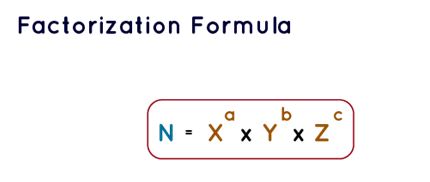
Factorization Formula: The technique of factorization employs a formula to break down a number into its constituent parts. Factorization involves decomposing an entity into a multiplication of other entities, referred to as factors. These factors, when combined through multiplication, yield the original number. By utilizing the factorization method, algebraic or quadratic equations can be simplified by transforming them into a form where the equations are represented as products of factors rather than expanding brackets. These factors within an equation can encompass integers, variables, or even algebraic expressions. In the subsequent sections, we will delve into the factorization formula, elucidating its concepts through solved examples.
What is Factorization Formula?
The factorization formula facilitates the rapid breakdown of a number into its constituent smaller numbers or factors. A factor is a numerical value that evenly divides the given number without leaving a remainder. The factorization formula for a given numerical value can be represented as follows:
factorization formula
In this context:

"N" denotes any numerical value.
"X," "Y," and "Z" symbolize the factors of the number "N."
"a," "b," and "c" represent the exponents corresponding to the factors "X," "Y," and "Z," respectively.
Also Check - Rational Numbers
Factorization Definition
In mathematics, factorization is the procedure of dissecting a number into smaller numerical components, which, upon being multiplied, yield the original number. These numerical constituents are known as factors or divisors. To illustrate, consider the number 12, which can be deconstructed into 3 × 4, with these two values being referred to as its factors.
Terms and Factors
Terms:
It pertains to components that are either included or subtracted (subtraction is essentially equivalent to adding a negative value) within an expression.
For instance, considering the expression 2x + 7, both 2x and 7 constitute the terms.
The sum is achieved by combining one term with another term.
Factors:
It is something that is to be multiplied in an expression.
Product = factor × factor
For example:
p = 4(2q – 6)
4 and 2q – 6 are the factors whereas 2q and 6 are the terms.
Also Check - Algebra Formulas
List of Factorization Formulas for Algebraic Equation
Several algebraic identities play a crucial role in aiding the factorization of algebraic expressions as well as quadratic equations. Presented below are a selection of these identities.
- (a + b) 2 = a 2 + 2ab + b 2
- (a − b) 2 = a 2 − 2ab + b 2
- (a + b) 3 =a 3 + b 3 + 3ab(a + b)
- (a – b) 3 = a 3 – b 3 – 3ab(a – b)
- (a + b) 4 = a 4 + 4a 3 b + 6a 2 b 2 + 4ab 3 + b 4
- (a − b) 4 = a 4 − 4a 3 b + 6a 2 b 2 − 4ab 3 + b 4
- (a + b + c) 2 = a 2 + b 2 +c 2 + 2ab + 2ac + 2bc
- a 2 – b 2 = (a + b)(a – b)
- a 2 + b 2 = (a + b) 2 - 2ab
- a 3 – b 3 = (a – b)(a 2 + ab + b 2 )
- a 3 + b 3 = (a + b)(a 2 – ab + b 2 )
Factorization Methods
There are four methods to factorise the algebraic expressions.
- Common factors method
- Regrouping terms method
- Factorisation using identities
- Factors of the form (x+a) (x+b)
Method of Common Factors
In this approach, we simply extract the shared factors from each term of the provided expression.
Illustration: Let's factorize 3x + 9.
Since both terms, 3x and 9, have a common factor of 3, we can factorize them as follows:
3x + 9 = 3(x+3).
Technique of Rearranging Terms
Rearranging involves reordering the given expression based on similar or like terms.
For instance, consider the expression 2xy + 3x + 2y + 3:
2xy + 3x + 2y + 3
Expanding these terms into factors:
= 2 × x × y + 3 × x + 2 × y + 3
Rearranging to identify the common factor:
= x × (2y + 3) + 1 × (2y + 3)
Now, the common factor is (2y + 3) which can be extracted:
= (2y + 3) (x + 1)
Hence, these are the desired factors.
Download PDF Factorization Formula
Factorization through Identity Utilization
By employing common algebraic identities, we can perform the factorization of the given expression.
For instance, let's factorize 4x^2 – 9.
Solution: Utilizing algebraic identities, we know that:
a^2 – b^2 = (a – b) (a + b)
Hence, we can rewrite:
4x^2 – 9
= (2x)^2 – 3^2
= (2x + 3) (2x – 3)
Note: Refer to the factorization formulas mentioned above for the other identities.
Factors in the Form (x+a) (x+b)
When an expression takes the form x^2 + (a + b) x + ab, its factors become (x+a) and (x+b).
For instance, let's factorize x^2 + 5x + 6.
Solution: When comparing the given expression with x^2 + (a + b) x + ab, we deduce that:
a+b = 5 ….(i)
ab = 6 ….(ii)
By substituting values for a and b that satisfy the above two equations:
If we let a = 4 and b = 1, a + b = 5 matches eq.(i), but a.b = 4 does not match eq.(ii).
Similarly, if a = 2 and b = 3, a + b = 5 satisfies eq.(i), but a.b = 6 does not satisfy eq.(ii).
x^2 + 5x + 6
= x^2 + (2 + 3)x + 2×3
= x^2 + 2x + 3x + 2×3
= x(x+2) + 3(x+2)
= (x+2) (x+3)
Factorization Formula FAQs
What Does N Mean in Factorization Formula?
Explain what do the variables X, Y, and Z Represent in Factorization Formula?
What Do a, b, c Represent in Factorization Formula?
How to Factorize the Given Algebraic Expressions?










